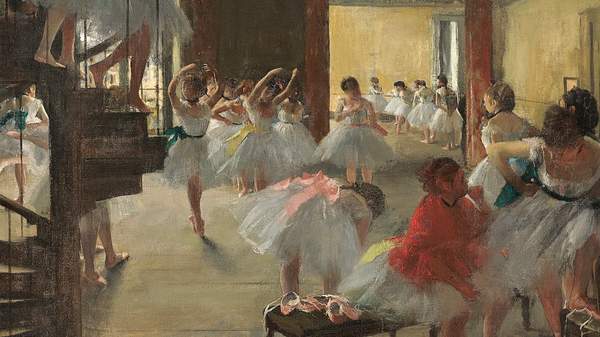Overview
With the enormous Andy Warhol | Ai Weiwei exhibition wrapped up, Next Wave Festival done and dusted for another year and Whistler's Mother flying in (and out) for a short visit, this year has marked a big year for art in Melbourne — and we're only half way through. To kick off the second half of the year, we'll be diving into the the NGV's huge new Degas exhibition, making a trip to Geelong Gallery and visiting Flinders Lane lobbies to get our art fix. If you read on, you can do the same.
Words: Matt Abotomey, Tom Clift and Imogen Baker.
-
5Read more Buy Tickets
Degas: A New Vision will run from June 24 to September 18 at the NGV International and is comprised of over 200 works by French Impressionist artist Edgar Degas, from collections the world over. For those of you who don’t know, Degas is a pretty big deal in the art world and practiced during the late 1800s-early 1900s. At a time when many artists where still painting posed works, Degas and a sect of bohemian Parisian artists (including Honoré Daumier and Henri de Toulouse-Lautrec), were cultivating the first big art movement that focused on candid impressions of subjects en plein air (meaning in ‘open air’ style, as opposed to in the studio or from memory). A lot of his pieces feature ballerinas and inevitably, this did lead to a lot of lurking around backstage at the ballet and, in Lautrec’s case, in a tonne of brothels (for the artistic potential, surely).
Degas’ work also focused on an infrequently explored subject: the everyman. Blue collar workers in their natural habit where a recurring and novel theme in his work; French Impressionism tapped into that vein of human curiosity that makes reality TV so popular (“They’re just like us!”). Degas actually rejected the Impressionist mantle and referred to his style as realism, so intent was he on representing the world around him. In fact, according to art historian Carol Armstrong, Degas said “No art was ever less spontaneous than mine. What I do is the result of reflection and of the study of the great masters; of inspiration, spontaneity, temperament, I know nothing”. Well damn. We can’t wait to check it out.
-
4Read more
Art, technology and the human experience coalesce at a new exhibition at Geelong Gallery. Presented in partnership with the University of NSW and Museums and Galleries NSW, People Like Us features the work of a number of contemporary artists from around Australia and the world, and combines sound, music, the moving image and interactive technology to explore the way new media influences our lives.
On display at the gallery until August 21, People Like Us encourages visitor interaction. Take a virtual bike ride through Sydney, journey through human blood vessels, or download an app that syncs a multimedia artwork with the rhythm of your heart.
Other highlights of the free exhibition include a symphonic tribute to the victims of the Hillsborough human crush disaster, a video work featuring a robotic surgical procedure, and a series of audio portraits of purring cats. If that’s not worth taking the trip to Geelong, then we don’t know what is.
-
3Read more
Get a glimpse into the production of an intriguing adaptation of Oscar Wilde’s savage fairytale The Nightingale and the Rose. Co-directed by two-time Archibald Prize winner Del Kathryn Barton and filmmaker Brendan Fletcher, the 14-minute animation — which won the award for Best Australian Short Film at last year’s Melbourne International Film Festival — will screen as part of a three-month exhibition at the Australian Centre for the Moving Image.
Featuring the voice talents of Mia Wasikowska, David Wenham and Geoffrey Rush, as well as a unique score by singer-songwriter Sarah Blasko, the film provides the backbone for Del Kathryn Barton: The Nightingale and the Rose. Running until mid-September in ACMI’s Gallery 2, the exhibition will take visitors behind the scenes of Barton’s creative process, incorporating never-before-seen paintings, props from production, and a rare 1913 edition of the Oscar Wilde anthology in which the story first appeared.
-
2Read more
For those who prefer their cat photos from the trippier side of town, Bronni Krieger’s Unspoken is going to need your full attention. In these detailed paintings on display at fortyfivedownstairs during July, animals abound — but it’s not the usual dog in socks or hedgehog in a shower cap fodder the Internet usually lobs at us.
Krieger’s paintings are photorealistic, but work to transport the viewer into a dream space. From a lamb munching on grass growing out of an old armchair, to a faun entranced by a toy buck in a terrarium, Krieger’s subjects are undisturbed by any human presence. They emerge from a grey haze, interacting with man-made objects and environments with bewilderment and innocence.
Unspoken not only looks beautiful, but also carries a sense of mystery and sadness. How many gifs of cats escaping bike helmets can make a similar claim?
-
1Read more
Mailbox Art Space is snug. Snug to the point where it’s difficult to imagine one artist being able to squeeze their works into the space (which amounts to a mounted mailbox and its surrounds), let alone four. But that’s precisely what Belle Bassin, Leanne Hermosilla, Valentina Palonen and Anna Parry have set out to do in Heathen, their first collaboration for the small Flinders Lane art space.
Showing in the foyer of the historic Pawson House building from July 6-30, the exhibition is an exploration of “mysticism, the numinous and the unknowable”. The combination of four dramatically different styles in such a compact space promises to make for a compelling study of what lies behind the veil of the tangible.
Top image: Edgar Degas, The dance class, c. 1873, oil on canvas, 47.6 x 62.2 cm, National Gallery, Washington D.C., Corcoran Collection (William A. Clark Collection), (2014.79.710), © Courtesy of National Gallery, Washington.
